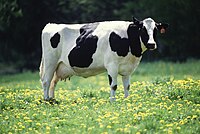
Photo from wikipedia
The purpose of this study is to compare five protocols of estrous synchronization for Hu ewes to obtain the most effective and economical protocol, to apply the advantageous scheme in… Click to show full abstract
The purpose of this study is to compare five protocols of estrous synchronization for Hu ewes to obtain the most effective and economical protocol, to apply the advantageous scheme in large-scale sheep farming. Healthy multiparous Hu ewes (n = 150) were randomly divided into five groups, and all ewes were administered fluorogestone acetate (FGA, 45 mg) vaginal sponge. The sponges of the first three groups (Groups I, II, and III) were removed on the 11th day, and 0.1 mg of PGF2α was injected intramuscularly on the ninth day. Group I received 6 μg of gonadotropin-releasing hormone (GnRH) by intramuscular injection at 36th h after withdrawal of the sponge. Group II was injected 330 IU of pregnant mare serum gonadotropin (PMSG) on the ninth day. The combination of 6 μg of GnRH and 330 IU of PMSG was treated in Group III at the same time as Group I and Group II. The sponges of the latter two groups (Groups IV and V) were removed on the 13th day, and 330 IU of PMSG was injected intramuscularly simultaneously. PGF2α (0.1 mg) was administered on the 12th day in Group IV. All ewes were detected for estrus at 24, 36, 48, 60, and 72 h after the sponge removal. The loss of sponge and vaginitis was recorded when the sponge was withdrawn. Cervical artificial insemination (AI) was performed with fresh semen of Dorper rams diluted with skimmed milk. After 30 days of insemination, the conception was detected with a veterinary B-ultrasound scanner. The lambing status of all ewes and the cost of drugs for estrous synchronization in each group were recorded. The results showed the following: (1) on the whole, the average percentage of estrous ewes in the period of 24–36 h and 36–48 h after removal was significantly higher than other three periods and that of the period of 60–72 h was significantly lower than the first three periods after removal; (2) there was no significant difference in percentages of estrous ewes in any of the five time periods, sponge loss rate, vaginitis rate, total percentage of estrous ewes, conception rate, single lambing rate, twinning rate, and multiple lambing rate of ewes among five protocols; (3) total percentage of estrous ewes and conception rate were more than or equal to 80% in the Groups II and III, and the twinning lamb rate of the Group II protocol was 70%; (4) there was no difference in lambing rate of ewes among Groups II, III, IV, and V; (5) the Group III had the highest drug cost of 22.5 CNY. In conclusion, considering the lambing rate, twinning lamb rate, and drug cost for estrous synchronization, Group II was the most advisable for application and promotion in large-scale sheep farms among these five protocols of estrus synchronization.
Journal Title: Frontiers in Veterinary Science
Year Published: 2022
Link to full text (if available)
Share on Social Media: Sign Up to like & get
recommendations!